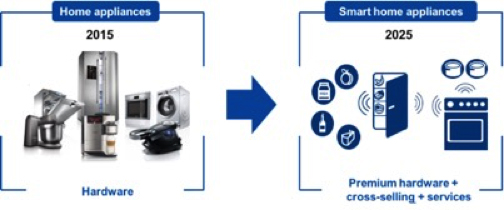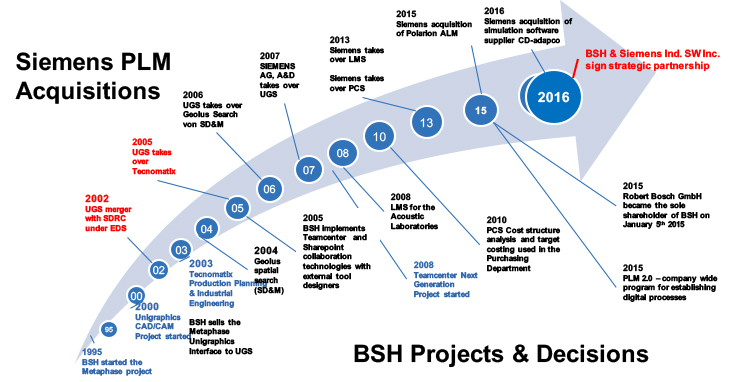Key takeaways:
- The trend toward smart, connected products and the emergence of the Internet of Things are changing both product complexity and how businesses must operate and compete—resulting in both new opportunities and new challenges
- R&D leaders must own PLM as their strategic enterprise platform
- Companies need to establish a Product Architecture Management Strategy
- Companies must think and develop in a system of systems paradigm
Introduction
Technology is rapidly changing the definition and design of products. They are no longer just electro-mechanical devices. Embedded electronics and software as well as cloud connections provide much of the functionality and differentiation between product models and variations. Products have become smart, connected devices that communicate with one another and to other systems using the Internet, hence the name Internet of Things (IoT). This change is effecting every kind of product from airplanes to cars and home appliances. Companies are scrambling to develop their connected strategy and implement working solutions. Home appliances manufacturers are rapidly progressing along this path, many products have touch panel displays, links to the Internet, and can be monitored for performance and service by their manufacturer.
Developing and delivering these new home appliances to the market is the endeavor of BSH Hausgeräte GmbH (BSH Home Appliances), the largest manufacturer of home appliances in Europe and one of the leading companies in the sector worldwide. Founded in 1967 as a joint venture between Siemens AG and Robert Bosch GmbH, BSH operates some 40 factories around the world. Its product offerings include large home appliances as well as a multitude of small appliances such as fully automatic espresso machines and hot water appliances (consumer products). Together with a global network of sales and customer service firms, the BSH conglomerate today is made up of about 80 companies in 50 countries, with a total workforce of more than 56,000 people. BSH invests approximately 4% of its revenues in research and development (R&D) It has around 3,500 R&D specialists in international production and development and more than 8,000 customer service specialists in about 50 countries.
BSH has a rich tradition in PLM investment, both in PLM enabling technology, but also investments in processes. Their PLM strategy and initiatives continue to evolve to address changing technologies and support the need to create the smart, connected products and systems being required by their customers.
Business Opportunities and Challenges
Technology and customer expectations are driving many changes:
- Products are becoming more complex and interconnected but smarter and more useful
- Embedded technology, e.g., software, is most often the differentiating factor
- Systems of systems, the only practical way to address the complexity, must be defined, designed, produced, and managed
- Massive amounts of data are being collected and must be aggregated and analyzed and then used to make actionable decisions
- Information is stored and shared using cloud infrastructure and solutions
- Available anywhere, anytime, on any device
- New collaboration and working paradigms are built on social media
The increase in product complexity in recent years is accelerating. Using embedded technology gives manufacturers a new way to add capabilities with enormous potential to profit since there is no additional material or manufacturing cost. But, it is forcing them to work differently and to develop or expand competencies in areas such as model-based systems engineering, agile software development, and supply chain management.
The good news is that these new capabilities are providing companies new opportunities to:
- Drive innovation with knowledge from analytics
- Sustain growth with software-based innovations and new services
- Keep price premiums, excite customers, and maintain brand value
- Create new business models
However, with new opportunities come new challenges including:
- New platforms, e.g., IoT, that are foreign to many companies
- Processes that span the product lifecycle, e.g., software updates of in-use products, rather than “fire and forget”
- Process re-engineering—not just process optimization
- Expanded security—more complex products and systems are more vulnerable
- Multiple eco-systems and the lack of clarity on what platforms will dominate in the future
- Product development complexity is shifting to systems of systems so people have to think and work differently

Figure 1—Evolution of Home Appliances
(Courtesy of BSH)
Figure 1 illustrates the changes in products, technology, and systems that are driving the home appliance industry. While today’s products may be smart and connected, they are still primarily just sold as products. BSH’s future vision is that these smart connected products will be one part of a broader portfolio that includes new premium services, parts, and other elements. This transformation is common among companies that see the IoT as a strategic opportunity.
To meet these new challenges, manufacturers need to change the way they develop the products and services their customers expect. This includes not only the products, but the processes to be followed, and, in many cases, the company’s business model—shifting from a product focus to a system-centric focus.
PLM 2.0 Purpose and Goal
BSH has had a strong, effective PLM strategy and programs for many years, including significant investments in technology and processes. They have a long partnership with Siemens PLM Software as Figure 2 illustrates. By frequently selecting tools from companies that Siemens PLM Software later acquired and incorporated into their PLM suite BSH was able to sustainably keep pace with PLM technology changes.

Figure 2—The History of BSH and Siemens PLM
(Courtesy of Siemens PLM Software)
To respond to challenges created by increasing use of embedded software described above, BSH’s software development grew from small teams to many hundreds. This growth and new development area has necessitated better integration between mechanical, electrical/electronic, and especially software groups using improved management and processes.
However, BSH believes that while their past PLM efforts were good investments that have delivered value, their current environment is not sufficient to move to the next level required for long term success. Going forward, BSH will have to focus on:
- Consumer centricity
- Brand differentiation
- Pushing digital transition and user experience
- Strengthening innovation
- Broadening their product portfolio to meet the needs of regional markets
- Driving operational excellence
- Evolving their leadership style
To achieve these goals BSH plans to do advanced optimization and harmonization of their processes with a special focus on the product data environment. As one important step toward this goal, they have created an engineering backbone that spans the product lifecycle from virtual product development to support the re-use of virtual and digital product definitions through sales, service, and IoT. A second key step is establishing a Product Architecture Management Strategy (PAMS). A product architecture is a strategy to manage a product line or family. The systems engineering concept of RFLP is the typical methodology. Requirements drive the functional design which drives the logical design which drives the physical design. This links architecture to system-level design and the principles of system engineering. It has profound implications for how the product is designed, made, sold, used, repaired, etc. With the advent of connected devices and systems of systems, it is important to establish a PAMS to define and maintain consistency across the connected devices, solutions, and services.
One of the issues BSH has uncovered is that while functional groups such as sales, marketing, and finance have a clear understanding of their product platform and tools, such as management cockpits, product developers are recognizing that they are behind the curve in consolidating information needed to support product development decisions. They have a clear understanding of engineering and manufacturing for products that are mainly mechanical in nature but when electronics and software are added, the dependencies are not well understood. It is critical that embedded and cloud software management is incorporated within standard processes because software is the key driver of customer value in a smart, connected world.
BSH has reached a tipping point—their business is no longer just converting raw material into finished goods, they need to produce solutions that meet and exceed customer expectations in many dimensions while participating in a dynamic, even chaotic connected world. For core processes and technologies, the integration aspect outweighs the best-of-breed applications approach, due to integration cost and complexity. BSH believes it is important for strategic technology vendors (e.g., SAP, Microsoft, Siemens PLM Software) to work together and to understand their role in helping large companies reach their strategic goals.
BSH believes that for end-to-end processes to be established and work effectively, companies need to have integrated enterprise platforms. CIMdata supports this belief. For example, ERP is just one platform, not the ONLY platform. There will be multiple business platforms, e.g., ERP, SCM, PLM, etc., so it is important that business people in engineering have a platform strategy. They need a clear roadmap for a PLM platform that supports system-centric products. R&D and Engineering need to take strategic ownership of an integrated PLM platform while supporting a target enterprise IT architecture that clarifies the relationships between enterprise solutions and platforms, like ERP and SCM. Working at the platform level to define and implement connections should help reduce cost by shifting integration efforts towards enterprise solution providers, including PLM.
Summary
Consumer products are evolving rapidly to incorporate embedded technology that delivers features people didn’t even know they needed but are now nearly indispensable. More importantly, many smart connected products create opportunities for new business models. However, these new product requirements and increased product complexity place enormous pressure on product companies. If they cannot adapt to these new product development challenges, they run the risk of going out of business.
BSH is an excellent example of a forward thinking company, one of the leaders in their industry, with a successful implementation of PLM. However, BSH recognizes that past efforts and success are not sufficient to maintain their competitive position into the future. They are establishing enterprise IT platforms including PLM and ERP that will better enable them to leverage their intellectual assets and people more efficiently and more cost effectively. CIMdata believes that this platform approach is essential for long term success in developing and delivering the increasingly complex products and systems of the future. CIMdata agrees with BSH’s view that R&D and Engineering must own PLM as their strategic enterprise platform and also establish a Product Architecture Management Strategy that can carry them forward.




